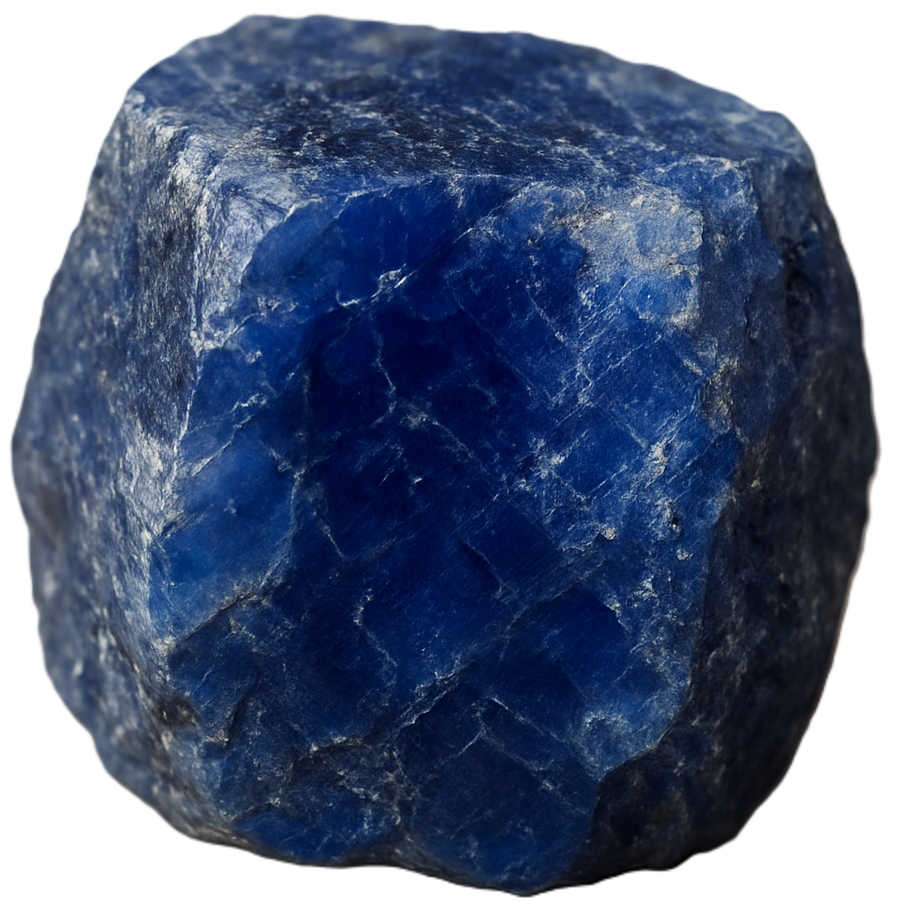
The name Sapphire derives from the Latin sapphirus and the Greek sappheiros, meaning blue stone. In ancient times, the term referred to several blue gems, including lapis lazuli, before being exclusively associated with the corundum mineral family. Blue sapphire is also known as Neelam in Sanskrit, Sapir in Hebrew, and Safir in Old French, all echoing its rich celestial hue. The word embodies wisdom, virtue, and divine favour across civilisations.
Composition, Physical Characteristics, and Varieties
Blue sapphire is a variety of the mineral corundum (aluminium oxide, Al₂O₃) and gains its distinctive blue colour from trace elements of iron and titanium. It ranks 9 on the Mohs hardness scale, making it one of the hardest natural gemstones after diamond.
Its colour ranges from pale cornflower blue to deep velvety midnight, with the finest stones displaying a vivid, medium to deep royal blue. The gem exhibits pleochroism, showing different shades when viewed from varying angles.
Varieties include:
- Kashmir Sapphire – prized for its cornflower-blue hue and velvety texture.
- Ceylon Sapphire (Sri Lanka) – known for lighter, vibrant blues.
- Padparadscha Sapphire – a rare pink-orange hybrid sapphire.
- Star Sapphire – features a six- or twelve-rayed star effect caused by rutile inclusions.
Geographical Locations
Blue sapphires are mined in several renowned locations worldwide, including:
- Kashmir, India – famed for legendary, silky blue stones.
- Sri Lanka (Ceylon) – a long-standing source of brilliant, clear sapphires.
- Myanmar (Burma) – produces deep royal-blue gems.
- Madagascar – now a leading modern supplier with stones of exceptional clarity.
- Thailand, Australia, and Montana (USA) – yield darker, inky varieties.
Archaeological and Significant Finds
Ancient Persian texts reference sapphire as the stone that gave the sky its colour. Sapphires adorned royal crowns and religious artefacts throughout antiquity. The earliest sapphire mines date back to Sri Lanka over 2,000 years ago.
One of the most famous examples is the Kashmir Blue Sapphire discovery in the 1880s, which supplied Europe with some of the world’s finest specimens. The Logan Sapphire, a 423-carat gem housed in the Smithsonian Institution, remains one of the largest faceted blue sapphires known.
The engagement ring of Princess Diana, later worn by Catherine, Princess of Wales, rekindled global admiration for this regal gem.
Historical and Current Usage
Blue sapphire has been used for centuries in crowns, amulets, ecclesiastical rings, and royal jewellery to symbolise virtue, truth, and protection. Ancient clergy wore it to connect with divine wisdom, while medieval kings believed it shielded them from harm and envy.
Today, blue sapphires remain coveted in fine jewellery, watches, and engagement rings. Their durability makes them ideal for daily wear, while their symbolism continues to evoke sincerity, loyalty, and faithfulness.
Interesting Facts
- The sapphire and ruby share the same mineral composition—corundum—differing only by trace elements.
- Heat treatment enhances colour and clarity in most commercial sapphires.
- The star sapphire’s unique optical phenomenon, asterism, is visible under direct light.
- Some sapphires fluoresce under ultraviolet light, revealing hidden characteristics.
- Ancient Persians believed the Earth rested upon a giant sapphire, giving the sky its blue hue.
Folklore, Superstition, Legends and Tales
Throughout history, blue sapphire has symbolised truth, nobility, and divine favour.
In medieval Europe, it was believed to protect the wearer from envy and poison. The clergy saw it as a connection to heaven, while in ancient Persia, it was said to guard against the evil eye.
In Hindu lore, blue sapphire (Neelam) is sacred to the planet Saturn (Shani). When worn correctly, it can bestow immense wealth and spiritual insight—but if misaligned, it was thought to bring challenges, making it one of the most powerful and unpredictable astrological stones.
Mystical Healing Properties
Blue sapphire is considered a stone of mental clarity, focus, and wisdom.
It promotes calm, self-discipline, and spiritual awakening. Believed to dispel mental confusion and emotional turmoil, it aids in self-expression and truth-seeking. Healers use it to soothe the nervous system, reduce stress, and support eye and thyroid health. Its cooling energy balances overactive minds and aligns with divine communication.
Astrology and the Zodiac
Blue sapphire corresponds primarily with the zodiac sign Libra, and in Vedic astrology, with Capricorn and Aquarius, governed by Saturn (Shani). It is said to enhance discipline, determination, and stability, granting success through perseverance.
Under Western astrology, sapphire supports those seeking mental clarity and emotional balance, making it beneficial for Virgo and Taurus natives as well.
The Chakra System
Blue sapphire resonates with the Third Eye (Ajna) Chakra and the Throat (Vishuddha) Chakra, stimulating intuition, insight, and truthful communication. It encourages spiritual awakening and higher consciousness while clearing blockages that hinder expression or understanding.
Birthstone and Wedding Anniversary
Blue sapphire is the birthstone for September and represents purity, loyalty, and wisdom. It is traditionally gifted for the 45th wedding anniversary, symbolising enduring commitment and deepening trust between partners.
Crystal Pairings: What Works Well and What to Avoid
Best pairings:
- Diamond – amplifies sapphire’s clarity and purity.
- Amethyst – enhances intuition and spiritual growth.
- Lapis Lazuli – deepens wisdom and truth.
- Clear Quartz – boosts the stone’s vibrational energy.
Avoid pairing with:
- Red Coral or Ruby – ruled by Mars, their fiery energy conflicts with Saturn’s steady influence.
- Pearl – ruled by the Moon, it may counteract sapphire’s discipline and focus.
